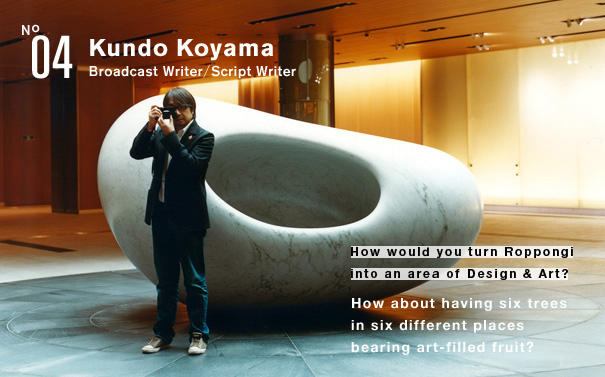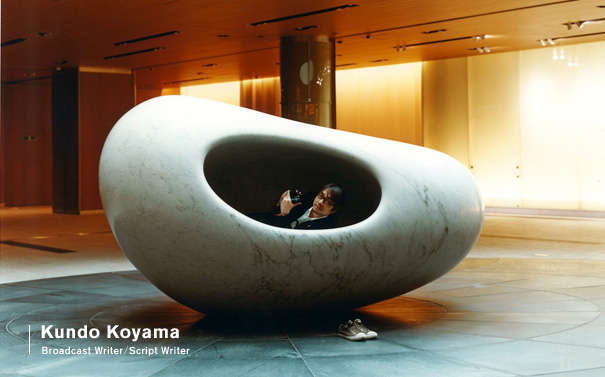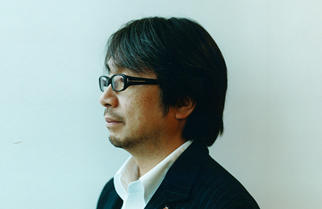
04 Kundo Koyama (Broadcast Writer / Script Writer)

- JP / EN
Kundo Koyama is a broadcast writer who has created many popular television programs, and is an expert at conceiving projects. The playful ideas he came up with to create the future of Roppongi sounded so attractive that we wished we could implement them at once. Koyama lived in Roppongi as a student, and there is a bar in this town that he has been going to for more than 20 years. He is a wine lover and also a camera aficionado. In his hands which hold the creative reins in public art, Koyama likes to carry his beloved Leica.
Six trees bearing art-filled fruit
Since the name of the place is "Roppongi" (six trees) I think you need to have six trees. How about having six trees in six different places bearing art-filled fruit? People come to see Christmas trees because they are season-specific. You could have six art trees that are place-specific and are unique to Roppongi. From the trees you could hang apple-like fruit, each containing art on various themes.
Until people pick the fruit, they don't know what kind of art is inside. It might be a picture folded up or a sculpture-like object. Or it could be a QR code which leads them to a website where a digital work is shown. Or perhaps the fruit might contain a map of the next place to visit. Artists can think up any plot they like. Don't you think it would be interesting if such things were hanging from trees?
The seeds from the fruits spread throughout Japan
Fruits are sweet because they want to be eaten, and they want to be eaten because they want their seeds to be carried. The aim is to have life carried far and wide to ensure continuity of life.
The art inside the fruit are the same as seeds. If people from all over Japan and all over the world picked up the fruits and took them home, the seeds would be transported and something new would grow in their respective destinations. For example, a person from Shimane Prefecture might come to Roppongi and pick a fruit that draws his or her attention from one of the six trees. Opening up the fruit, the person finds inside a work created by the art director Manabu Mizuno. There is a hidden scheme which becomes apparent only when that person returns to Shimane. Then at home, something unexpected happens that is associated with Roppongi. I think it would be interesting to set up that kind of device.
Involving more than just one person for a real-life SNS
The key point about the "six tree plan" to turn Roppongi into an area of design and art is that nothing is completed with just one person. The idea is to have many kinds of people involved and to connect the visitors to the town, and make things more fun. Perhaps it would be more like a social networking service (SNS).
People might come gather if you lined up numerous works by famous artists, but I don't think anything very surprising or new would emerge from that kind of event. There are so many towns or areas which exhibit art. Public art is scattered about New York, and simply lining up works is something that can be done anywhere. If you want to change Roppongi through art, you have to do something more adventurous.
You need to try something new like creating a real-life version of SNS. I think it would be meaningful to have such events in Roppongi where art serves a function of connecting people with the locale.

Roppongi is the pointy tip of Tokyo
My image of Roppongi is that it's not perfect, but a very pointy place. The town has its failures, and it's cluttered, but it's a place where the "edgy people" gather. The tallest point of Tokyo is now Sumida city because the Sky Tree has been built there. But the tip at the forefront of Tokyo has always been Roppongi.
When I was a college student, I lived near Hinokicho Park behind Roppongi and I would often ride my bicycle to go drinking in the downtown area. In the '80s, if you went to a popular disco, you would find people like Ryuichi Sakamoto next to you. There were loads of interesting people, and I had a sort of longing for that kind of cultural atmosphere. I think the most appealing aspect of cities is that they draw lots of interesting people. Cities probably shouldn't have rounded tips. They should be sharp, and pierce the way to the future.
Soaring expectations and Roppongi, the town of my youth
My interest in Roppongi began from my pre-college days, with the live house "Pit Inn" (*01). When I was a high school student, I was a fan of the band "Casiopea". Hearing that the band was performing at Pit Inn, I used to think, "Roppongi must be a fantastic place" and my expectations soared. (laughs) But when as a college student I visited Roppongi, I was surprised to see that there wasn't anything remarkable in the town at all. Tokyo Midtown and Roppongi Hills didn't exist then. It was just a disorderly night town, and I wondered what people find appealing about it. Those are my first memories of Roppongi.
*01 "Pit Inn"
a club with live music, known as a Fusion music Hall of Fame opened in August 1977 and closed in 2004 due to demolition of the building.
Then later on, I lived in Roppongi, so you could say it's the town of my youth. At that time, Seibu was the vanguard of culture in Tokyo, and there was a record shop in Roppongi called "WAVE" (*02) which also sold CDs and videos. I admired the video art of Nam June Paik, and I would look at his works at WAVE and dream of someday making similar visual artworks.
*02 "WAVE"
a record shop opened in 1983. The whole building was a center of various kinds of cultures like music and others. Closed in 1999 due to a redevelopment of the Roppongi area.
Tokyo is a splendid makunouchi-bento
Tokyo is stimulating and has good accessibility, and it's a fairly safe and convenient place. And there's more greenery that people might expect. Most of all, it's the number one place in the world for appetizing things. In other words, Tokyo is evenly packed with a wide variety of values, and it's like a makunouchi-bento (box lunches with many different kinds of food).
There are many nice towns in the world. Toscana in Italy is nice, as are places in Spain and Portugal. And if it's only the weather you are thinking about, Los Angeles and Hawaii are the best. But when everything is so nice, you feel happy just being alive, and you lose the desire for a lot of things. I think the reason new fashion is not created in Hawaii is that it's such a pleasant place, and when you live there, it seems moot to pay attention to details such as the shape of the collar.
I personally feel uneasy when I am not close to stimulation, so while Tokyo is not as pleasant as Hawaii, I can be stimulated in so many ways here, and it's a comfortable, well-balanced place for me. I think Tokyo is a splendid makunouchi-bento.

Dashi-soup and Japanese culture and cuisine
I earnestly wish to let more people know about the good things in Japanese culture. If I were to focus on one area, it would be the wonderful Japanese cuisine. If I were to introduce just one thing, it would be dashi-soup (soup stock). Dashi-soup is the most fascinating thing for me right now. I even hope that the Japanese word "dashi" will become a word used globally. Ochazuke (rice with tea) could be called "dashi rice" and udon (wheat-flour noodle) could be called "dashi noodle". Dashi is at the root of Japanese cuisine, and I feel that the concept of it is widely seen in in many other parts of Japanese culture.
In January this year, a party called "Japan Night" was held by the Japanese government at the annual meeting (of the World Economic Forum) in Davos. I was in charge of producing this party, and when I saw the VIPs of the world trying out the Japanese food, a strong feeling came over me that Japan should give out more information on its food culture in a better way than it is doing now. There's so much more than just sushi and sukiyaki.
The Japanese people have a very high level of food literacy. The food producers in Japan also have a strong awareness. Factors such the meticulousness and thoughtfulness of the Japanese are all reflected in the cuisine.
The simplicity and depth of dashi-soup is what design is about
Katsuboshi (dried bonito flakes) are marvelous, don't you think? The fish is caught and dried, and it takes about six months for it to become really hard, and then the flakes are put in hot water for flavoring. It's such a time-consuming method to make dashi-soup. And the appearance of it is not much different from salted hot water.
A lot of trouble is put into making it, but the end result is simple. Yet while simple, it has depth. It's a great form of design. For me, dashi-soup sums up what design is all about.
I had the walls of my house done by Hasado Shuhei, a plasterer from Hida Takayama. I watched him at work and saw that he had been plastering about seven layers. I said, "Shuhei-san, maybe it's not necessary to do it seven times?" and he replied, "It's necessary. It's what gives it depth." The surface is all that is visible, but I was impressed to learn that a wall plastered seven times has more depth than one that has been plastered only once. I felt that this too, is what design is about.
Art moves people through emotions than by logic
I was also impressed by the annular solar eclipse in May. All the TV stations were holding countdowns and they were telling us in great detail about how the sun and the moon would overlap at what hour and minute and how it would look from various locations. It all really turned out as they said, and I thought that astronomy and mathematics are amazing. And I said to mysself, "This is art."
I think anything that moves people through emotions than by logic is art. The annular solar eclipse was art. People knew a long time beforehand what would happen and why. You knew the logic behind the phenomenon, but (when you actually saw it) you were left speechless. I wonder how many of the 120 million people in Japan looked up at the sky on that day. So many people looked in the same direction and became aware of the relationship between the earth, moon and sun. That definitely was art.
Editor's thoughts
Kundo-san was playful during the photo shoot, saying that he couldn't allow us to take a photo of the left side of his face for the profile page. That made all the staff freeze for a moment before we realized that he was joking. Kundo-san proposed setting up six trees in Roppongi whose fruits could be picked, and whose seeds of art could spread across the country. It is an exciting idea that we would love to make a reality someday.(edit_rhino)



















